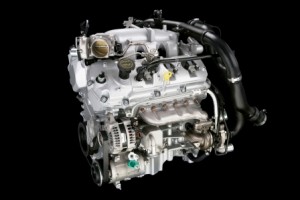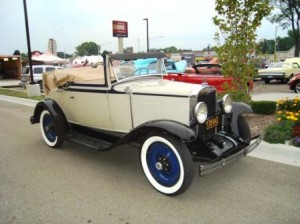There was a time, during Ford Model T days (1908-1927), when four cylinder engines absolutely dominated the American, indeed world, marketplace. Now it looks like we are returning to that era again, thanks to fears over gas prices, emission regulations and, at the moment, the economic Great Recession or Depression, whichever you care to call it.
Significantly, the striking fact is that nearly 90% of the top-selling Toyota Camry models sold in the U.S. market so far this year has been Fours, up from 82% in 2008. Fours in the Ford Fusion have been running around 65-70% of total sales and four-bangers in the Honda Accord reportedly constitute about three-quarters of those sold here.
Japanese makers led the way with smooth, balanced and efficient four-cylinder engines for the past decades, but there are signs the U.S. is catching up.
Today’s domestic Fours are vastly improved over those of the American maker past, perhaps led at the moment by Ford Motor Company’s forthcoming Ecoboost 1.6- and 2.0-liter engines, which are promised for European and Asian markets for the year ahead and the American market by 2013.
Ford’s announcement stated bluntly that 1.6 Ecoboosts would replace larger four cylinders and the 2.0-liter version would replace V6s, presumably providing equivalent or better performance with significantly better fuel economy. I expect competitors to match Ford one way or another, although customers could balk at the expense of the turbocharging or twin turbocharging, direct injection and control system. This is an expensive design.
In a joint promotion between Lincoln and a couple of monthly automotive magazines, a 2010 Lincoln MKS 3.5-liter Ecoboost V6 eclipsed four of Europe’s best V8s in a winding, climbing Pikes Peak shootout, barely loosing out to a BMW V8 which was faster in the turns. At 106 mph over the course, the Ecoboost captured the highest top speed of any of the five cars tested. This was astonishing on several fronts, and promises good vibes for the Ecoboost Fours coming soon, if the pricing and quality are right.
Old versus new
To recognize how much better today’s Fours, even without “boosting” technology, are than those of the past, consider a few ancient facts, especially noting output and compression ratios of the Oldies:
- Chevrolet was the first volume American automaker to abandon the Four, replacing it for 1929 with the Cast Iron Wonder Six, advertised as “A Six at the Price of a Four.” The older Chevy 171-cubic inch displacement (cid) Overhead Valve design produced 26 horsepower and gave way to the new OHV six-cylinder of 194 cubic inches and 46 horsepower. That handily bested the Ford Model A’s 200.5-cid Four which only put out 40 horsepower. The difference was Chevy’s 5.2:1 compression ratio vs. Ford’s 4.22. (the higher the compression ratio, the greater the expansion ratio of combustion gases and the higher the output.)
- Plymouth came next, retiring in 1934 its 196-cid Four of 65 horsepower for a 201.3-cid Six of 77 horsepower with a 5.8:1 compression ratio.
- Ford was last among the Big Three to fold its Four, carried over as Model B and C series for 1932-34 models after introduction of the legendary 65 horsepower 221-cid V8 in 1932. By 1935 Ford offered only an 85 horsepower V8, compression ratio having been increased from 5.5 to 6.3:1.
Why were Fours abandoned then?
The Sixes and Eights were smoother, quieter and more powerful, thus better suited to the paved roads that began to spread in the 1920s, permitting higher speeds and — with enclosed tops and optional heaters — more comfortable travel. It was a different story overseas. European governments promulgated horsepower taxes and engine displacement restrictions as a way to keep American-type cars out and raise revenue; they suffered exchange dollar shortages from World War I debt and had no Texas-sized petroleum deposits of their own.
American Fours began their comeback in the 1960s, with Pontiac’s “half-eight,” a slanted, sawed-in-half V8 for the 1961 Tempest and the 153.3-cid 90 horsepower OHV Four powering the Chevy II at its 1962 model introduction. Another boost came from Chevy Vega, Ford Pinto and, gasp, Mustang II Fours of the Seventies, followed by Chrysler’s four-cylinder K-cars and minivans. For the most part these were unsatisfactory engines – noisy, underpowered, out of balance compared with domestic six and eight cylinder motors. However, together with new transplant factories producing only Fours for Nissan, Honda and Toyota in the Eighties, the four cylinder was reborn.
In the early to mid-Eighties, Ford offered a turbocharged version of its 2.3-liter Four in Mustang GT and SVO models as well as the Thunderbird Turbocoupe. I had a 1985 Turbocoupe automatic that was very satisfactory, and we still have an equally pleasing 1984 Mustang Turbo GT convertible with a five-speed manual transmission in the family, now with well over 100,000 miles on the clock and nary an engine hitch. Don’t know why Ford abandoned the turbos then. (editor: the market abandoned them) Chrysler applied turbos to their basic K-car Fours to make them suitable for upscale Chryslers in the same decade.
Now compare the Fours of the Twenties and Early Thirties, which powered millions of cars in their days, with today’s best Fours, again noting horsepower and compression ratios. For example, the excellent 2.4-liter (145-cid) VVT “Ecotec” Four in the Chevrolet Malibu produces 169 horsepower with a compression ratio of 10.4:1. Ford’s “Duratec” 2.5-liter (152-cid) Four in the gas-sipping 2010 Fusion whips out 175 horsepower with a 9.7:1 compression ratio. Chrysler/Dodge mid-sized Sebring/Avenger sedans offer a 2.4-liter Four of 173 horsepower with 10.5:1 compression ratio. Toyota has a new 2.5-liter Four for the 2010 Camry, rated at 169 horsepower with a 10.4:1 compression ratio. One potential hitch here is the requirement of some of these high tech engines to use premium fuel, which customers don’t like.
You can see these Fours are very competitive in specifications and are vastly more efficient than their ancestors, easily achieving mid-30s highway mpg ratings. In addition, where available, hybrid versions of these cars all use Fours.
Compare today’s Four dominance with the fate of a Four in the original Ford Taurus of 1986. Many have forgotten Taurus offered an 88-horsepower 2.5-liter Four through the 1991 model, but sales (and performance) of Taurus Fours were so anemic that hardly anyone knew they existed, which was probably just as well for Ford’s reputation. In 1990, out of nearly 1.8 million passenger car engines produced by Ford Motor Company, fewer than 5,000 were of the Taurus Four.
Times have changed and the Age of the Four has returned for good, both to the American car market and to Detroit’s main producers.
###



Don’t forget that the 2.3 Lima was also used in the Merkur XR4Ti. As cantankerous as the early injected turbo systems were, that was still a heck of a ride.
Nice job remembering the 2.5 in the Taurus. Very rare now, I would think.
Indeed I did forget the Merkur, perhaps because I was only thinking domestically. My niece had one and after commuting in it for several years, passed it along to other family members. If there were ever any engine problems with it, I never heard of them. Our Turbo Mustang gives the performance of a V-8 with the economy of a Four, and handles beautifully with the light front end.
Mike